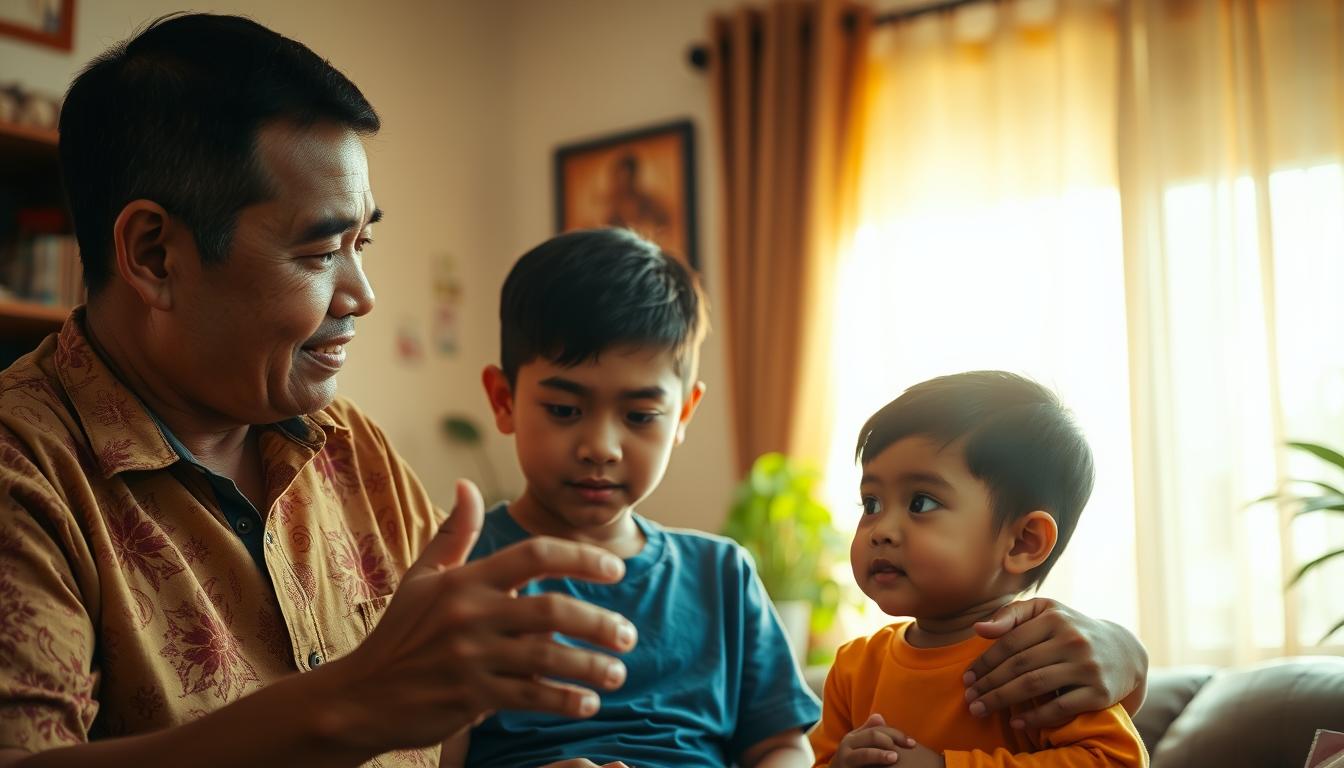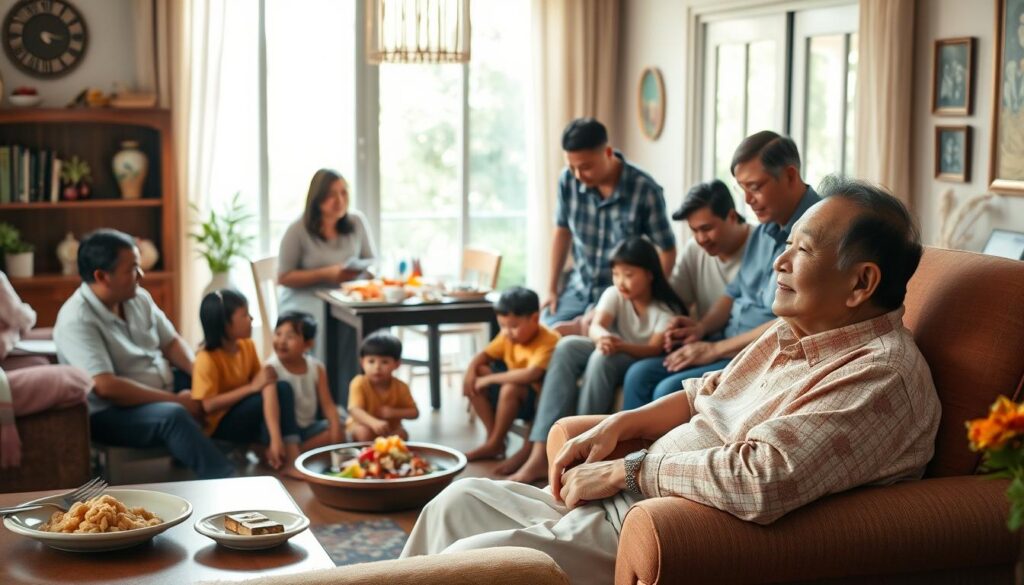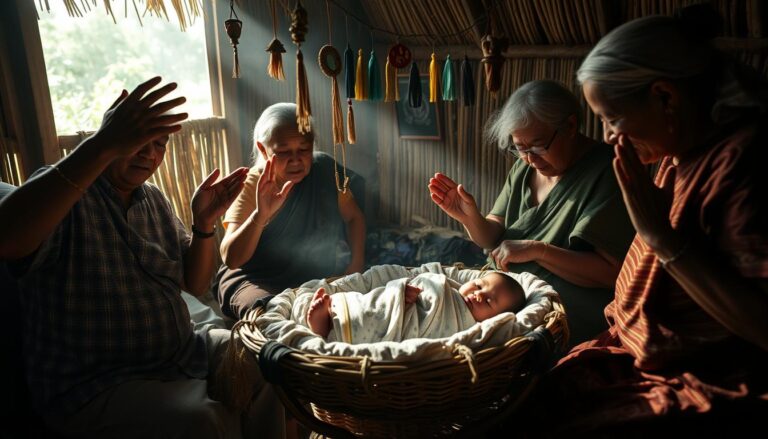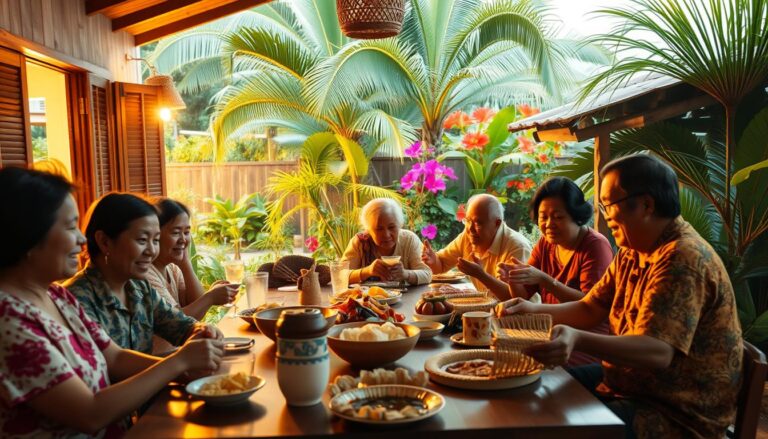Filipino Child-Rearing: Discipline Values That Shape Kids

Parenting practices rooted in tradition often reflect a society’s deepest values. In many communities, methods of teaching respect and responsibility blend time-honored customs with evolving modern ideals. This balance creates unique approaches to guiding children’s behavior while preserving cultural identity.
Many families emphasize authority and obedience as cornerstones of character development. Practices like verbal reminders or corrective actions are commonly used to reinforce expectations. These strategies aim to cultivate respect for elders and social harmony, often tied to concepts like honor and collective reputation.
Recent shifts show younger generations adopting more collaborative methods. Education and changing gender roles influence how caregivers approach guidance. While physical consequences remain part of some households, studies suggest higher education levels correlate with reduced use of strict measures.
Key Takeaways
- Cultural values strongly influence approaches to teaching respect and responsibility
- Traditional methods often prioritize family reputation and social harmony
- Modern trends show increased emphasis on dialogue over strict authority
- Educational attainment impacts preferences for disciplinary strategies
- Gender roles are evolving in caregiving responsibilities
Introduction to Filipino Child-Rearing: Culture and Values
In many cultures, raising children is a tapestry woven from community threads and ancestral wisdom. The Philippines stands out for its family-centered approach, where neighbors and relatives often share caregiving duties. This collective effort reflects a deep-rooted belief that every child belongs to the village.
Local parents blend time-honored practices with modern education systems. Grandparents teach respect through stories, while schools introduce collaborative problem-solving. Many households use this mix to prepare kids for both cultural traditions and global opportunities.
Extended family networks provide stability, especially when parents work abroad. Aunts, uncles, or godparents step in, ensuring children feel supported. One mother from Cebu explains: “We trust our relatives to guide them when we can’t—it’s how we keep bonds strong.”
Community programs and religious groups reinforce key values like compassion and responsibility. These efforts create safety nets that help young people thrive despite economic challenges. As societal roles evolve, many caregivers now balance discipline with open dialogue.
Education reshapes parenting methods too. Teachers encourage critical thinking, which some families adopt at home. This shift shows how cultural foundations adapt without losing their core identity—a dance between heritage and progress.
Traditional Values in Filipino Child-Rearing
Guiding young minds often revolves around preserving collective identity. Many communities prioritize honor and social harmony, using time-tested methods to instill responsibility. These approaches blend emotional awareness with clear behavioral expectations.
Cultural Influences on Discipline
Extended family networks play a key role in reinforcing conduct standards. Aunts, uncles, or grandparents often step in to correct behavior, ensuring children learn respect early. One mother shares: “When my son misbehaves, his godmother reminds him—everyone’s watching.”

Honor, Hiya, and Familism
Concepts like karangalan (dignity) shape daily interactions. Parents might say, “Think of our name,” linking actions to family reputation. This focus on collective standing encourages children to avoid actions causing hiya—shame that impacts relatives.
Common practices include storytelling to teach humility or assigning chores to build accountability. Elders often use gentle reminders rather than harsh punishments. As one grandmother notes: “We correct with love, so they remember why it matters.”
Relatives collaborate to model respectful communication. This united front helps kids understand community expectations while feeling supported. Such traditions remain vital, even as modern methods gain traction.
Historical Context of Filipino Parenting
Historical demographic trends reveal patterns in nurturing future generations. For over 300 years, colonial influences blended with indigenous traditions to shape family dynamics. Spanish-era records show elders prioritizing communal responsibility, while American occupation introduced formal education systems.
A 2021 study tracked changes across three decades. Researchers found parents set more rules as children approach adolescence, peaking around age 12. This aligns with traditional values emphasizing heightened accountability during formative years.
Modern challenges like overseas work arrangements test historical frameworks. Nearly 25% of families now rely on relatives for daily care—a practice dating back to pre-colonial clan systems. One teacher observes: “Kids today navigate two worlds—their grandparents’ traditions and global youth culture.”
| Era | Key Features | Discipline Approach | Data Source |
|---|---|---|---|
| Pre-1900s | Oral traditions | Community mentorship | Ethnographic records |
| 1970s-2000s | Urban migration | Extended family guidance | Census reports |
| Present | Digital influence | Hybrid methods | Alampay & Rothenberg study |
Longitudinal data shows parental warmth decreases slightly as children grow, while rule-setting increases. These shifts reflect attempts to balance heritage with contemporary child development needs. Schools now collaborate with families to reinforce respect—a modern twist on ancestral teaching methods.
Extended Family: The Filipino Support System
Communities thrive when multiple generations collaborate in nurturing the young. In the Philippines, extended families create a safety net where grandparents, aunts, and uncles share daily responsibilities. This collective approach ensures children receive consistent guidance while parents manage work or other obligations.

Role of Relatives in Childcare
Relatives often handle tasks like feeding infants or helping with homework. One mother notes: “My sister picks up my kids from school when I’m stuck at work—it’s our normal.” Grandparents frequently teach values through stories, while godparents provide emotional support during tough phases.
| Family Member | Primary Role | Impact |
|---|---|---|
| Grandparents | Moral guidance | Teach cultural traditions |
| Aunts/Uncles | Practical care | Assist with daily routines |
| Godparents | Emotional support | Boost self-confidence |
Impact on Child Independence
Shared caregiving helps children adapt to different environments. Kids learn to communicate with varied age groups and solve problems independently. Studies show those raised in family networks often display stronger decision-making skills by adolescence.
This system reduces pressure on parents while giving kids diverse role models. As one teacher observes: “Students from tight-knit clans usually navigate group projects with ease.” Such collaboration builds resilience—a cornerstone of healthy child development.
Young Parenthood & High Fertility Rate Trends
Shifting demographics in Southeast Asia reveal complex patterns in family planning and youth development. Recent data shows the region’s fertility rates remain among Asia’s highest, with unique challenges emerging from early parenthood trends.
Social Implications of Early Parenthood
Over 13% of women become mothers by age 19—double the rate from two decades ago. Rural areas see higher averages, with women having 4.3 children compared to urban residents’ 3.0. This gap often links to limited access to education and healthcare resources.
Young mothers face unique hurdles. Birth intervals average 19 months for teens versus 34 months for older parents. One nurse shares: “Teen patients often juggle school and childcare—it’s like they’re racing against time.” These tight timelines can strain emotional bonds and financial stability.
| Age Group | Average Children | Unmet Contraception Needs |
|---|---|---|
| 15-19 | 1.2 | 28.7% |
| 20-24 | 2.1 | 22.2% |
| 25+ | 3.5 | 15.8% |
Parenting approaches differ sharply by age. Older caregivers often emphasize structured routines, while younger ones may rely on extended family support. Wealth disparities compound these differences—40% of low-income women have children by 24, versus 11% in higher-income groups.
Educational outreach shows promise. Studies indicate teens communicating openly with mothers about relationships have lower pregnancy rates. Community programs now blend traditional values with modern health education to address these complex dynamics.
Child Discipline and Punishment in Filipino Parenting
Navigating behavioral guidance reveals a cultural crossroads where ancestral methods meet contemporary psychology. Many households blend strict accountability systems with emotional connection, creating layered approaches to shaping conduct.

Authoritarian Versus Modern Practices
Traditional methods often involve physical consequences like light spanking or standing in corners. A 2022 study found 74% of caregivers consider these measures effective for immediate compliance. One father explains: “We follow what our parents did—quick corrections teach lasting respect.”
Progressive attitudes prioritize dialogue over control. Mothers with college degrees are 40% less likely to use strict punishment, according to Manila University research. Instead, they employ time-outs or logical consequences tied to misbehavior.
| Approach | Discipline Method | Parental Role | Data Source |
|---|---|---|---|
| Traditional | Corporal punishment | Authority figure | 2022 NCR Survey |
| Modern | Collaborative problem-solving | Guidance partner | Alampay & Reyes Study |
Legislative changes reflect shifting attitudes. While the Family Code permits moderate physical discipline, new bills promote non-violent methods. These efforts align with global initiatives to end childhood violence by 2030.
Many parents now mix strategies. A teacher shares: “Families might use time-outs for minor issues but enforce stricter measures for safety rules.” This balance maintains cultural values while embracing child development research.
Hands-On Parenting and Attachment
Proximity-based care strategies bridge emotional needs and practical realities. Many caregivers prioritize constant physical contact, creating bonds through everyday interactions. This approach combines biological instincts with cultural wisdom passed through generations.
Mothers often carry infants in cloth slings for 12+ hours daily. “I breastfed my daughter until she started preschool—it kept her healthy and close,” shares a parent from Quezon City. This practice allows multitasking while maintaining skin-to-skin contact critical for early development.
Three Pillars of Physical Closeness
Three key methods dominate attachment-focused care:
| Practice | Average Duration | Key Benefit |
|---|---|---|
| Co-sleeping | 4-7 years | Enhanced emotional security |
| Babywearing | 8 hrs/day | Motor skill development |
| Breastfeeding | 2.5+ years | Immune system boost |
Urban infrastructure shapes these choices. Narrow streets and crowded buses make strollers impractical. Carrying children becomes both tradition and necessity—a hands-on solution fostering adaptability.
Research shows this tactile approach accelerates language acquisition. Infants hear 30% more words daily when carried versus stroller use. Early exposure to varied environments builds cognitive flexibility, preparing children for diverse social settings.
Grandparents often reinforce these methods. A study found 68% of caregivers learned babywearing techniques from older relatives. This intergenerational knowledge transfer keeps parenting practices rooted yet adaptable to modern life.
Celebrations: Baptism and Birthday Festivities
Milestone events serve as cultural anchors, weaving spiritual meaning into family life. Baptisms and birthdays bring communities together, creating shared memories that reinforce bonds across generations. These gatherings highlight how families prioritize collective joy over individual achievement.

Baptisms often occur within a child‘s first year, blending Catholic traditions with vibrant local customs. One mother explains: “We chose eight godparents—they represent pillars of support for our daughter’s journey.” Extended relatives typically cover 60% of celebration costs, demonstrating their investment in the child‘s future.
| Event | Key Participants | Typical Elements | Symbolic Meaning |
|---|---|---|---|
| Baptism | Godparents, priest | White gown, candle ceremony | Spiritual belonging |
| Birthday | Extended family | Lechon roast, games | Growth celebration |
First birthdays feature family-style feasts with dishes like pancit noodles for longevity. Teens mark adulthood through debut balls at 18, where 18 roses symbolize blessings. These rituals teach children about communal respect through active participation.
Parents collaborate with cousins and neighbors to organize events—a practice strengthening intergenerational ties. As one godparent notes: “Our role isn’t just ceremonial; we’re backup guides for life’s challenges.” This shared responsibility model helps kids understand their place within a wider support network.
Exposure to Life’s Hardships: Poverty, Death, and Natural Disasters
Over 17 million children grow up facing daily challenges like food insecurity and frequent typhoons. These realities shape childhood experiences, turning adversity into classrooms for life skills. A 2023 study found kids in disaster-prone areas develop problem-solving abilities 40% faster than peers in stable environments.
Resilience and Hard Work as Life Lessons
Early exposure to loss teaches resourcefulness. When floods destroy homes, families rebuild together—children often lead cleanup efforts. “We learn to work hard because life doesn’t wait,” shares a community leader from Leyte.
Three key traits emerge from hardship:
- Adaptability: Switching schools after disasters
- Tenacity: Selling crafts to supplement income
- Empathy: Caring for younger siblings during crises
Urbanization brings new pressures. Crowded cities expose children to crime and pollution. Yet NGOs like Zero Extreme Poverty PH 2030 create safety nets through tutoring and meal programs. These support systems help transform struggles into stepping stones.
Research shows childhood challenges build grit. Manila University tracked 500 teens—those overcoming poverty scored higher in teamwork and creativity. As society evolves, blending traditional resilience with modern resources prepares youth for an unpredictable world.
Superstitions and Traditional Beliefs in Child-Rearing
Ancient belief systems continue shaping caregiving practices across generations. Many families blend ancestral wisdom with modern education, creating unique approaches to nurturing children. These traditions reflect deep connections between cultural identity and developmental milestones.

Pregnancy Myths and Pre-Natal Customs
Expectant mothers follow specific guidelines believed to influence their baby’s future. Avoiding dark-colored foods prevents “darkened skin,” while consuming twin fruits like bananas may increase chances of multiple births. Some avoid haircuts or neck accessories, fearing restricted growth. “My lola warned me—no nail polish! It could suffocate the baby,” shares a mother from Cebu.
| Superstition | Purpose | Modern Adaptation |
|---|---|---|
| Burying placenta | Ensure good behavior | Hospital disposal with blessings |
| Coconut water intake | Induce labor | Medical induction alongside rituals |
Labor, Delivery, and Postpartum Rituals
Families often employ practices merging spiritual protection with physical care. Squash leaves placed on the abdomen ease contractions, while fathers bury placentas to stop maternal bleeding. New mothers avoid baths for weeks, using herbal steam instead. A midwife notes: “We combine massage techniques with prayer—it comforts families.”
Breastfeeding practices reveal careful balance. Some delay feeding colostrum, while others avoid nursing when stressed. These customs coexist with child development research, showing how knowledge evolves without erasing heritage. As hospitals expand access, many blend clinical care with time-honored rituals.
Shifting Gender Roles: Mothers and Fathers in Parenting
Over 60% of Filipino migrant workers are now women, reshaping household dynamics nationwide. This shift challenges long-held norms where fathers focused on financial provision while mothers managed childcare. A Manila University study reveals 42% of stay-at-home dads now handle daily routines like meal prep and homework help.
Modern Versus Traditional Attitudes
Traditional attitudes positioned men as final decision-makers. One grandfather recalls: “We worked, wives raised kids—that was our duty.” Today, 67% of urban couples share disciplinary control equally, per 2023 National Household Survey data.
| Role Aspect | Traditional Approach | Modern Shift | Data Source |
|---|---|---|---|
| Discipline | Fathers as enforcers | Joint decision-making | PSA 2022 |
| Nurturing | Mothers only | Fathers lead 38% of care | Alampay Study |
| Financial Care | Male responsibility | Dual-income households | BSP Report |
Migrant mothers increasingly trust partners with emotional support roles. “My husband understands our son’s school struggles better now,” shares an OFW nurse. Educational attainment drives change—college-educated fathers are 3x more likely to reject strict gender roles.
While 54% of rural families maintain traditional divisions, urban areas show rapid evolution. This balancing act preserves cultural roots while preparing children for egalitarian futures. As one teen observes: “Dad cooks, Mom fixes cars—it’s normal for us.”
Socio-Cultural Influences on Career and Responsibility
Career decisions are rarely solitary acts in communities where family honor guides professional trajectories. A 2023 study found 78% of working adults consider relatives’ opinions when choosing jobs. This collective mindset turns individual ambitions into group projects balancing personal growth with societal expectations.
Parents often steer children toward stable professions like medicine or engineering. “My father said law protects our name,” shares a Manila accountant. These choices reflect deep-rooted values linking work ethic to familial respect. Financial providers and moral guides, caregivers shape both paychecks and principles.
| Career Driver | Individual Choice | Family Influence |
|---|---|---|
| Job Selection | Personal interest | Collective reputation |
| Work Hours | Work-life balance | Filial obligations |
| Income Use | Savings goals | Multi-generational support |
Young professionals face dual pressures. A marketing specialist explains: “I send half my salary home while building my career—it’s expected.” This interwoven responsibility system creates adults who view success through communal lenses rather than personal gain.
Society reinforces these patterns through informal networks. Job referrals often come from relatives, tying employment opportunities to family connections. As globalization spreads, parents increasingly balance traditional values with children’s aspirations for international careers—a delicate dance between heritage and modernity.
Educational Impacts in Filipino Parenting
Classrooms and living rooms merge in households prioritizing academic growth. A 2023 study found 89% of parents view education as their children’s primary path to stability. This belief drives daily routines—many families enforce homework completion before playtime or chores.
Teachers and caregivers collaborate through programs like Childhope Philippines’ STEP, which blends literacy with values training. One mother explains: “We check notebooks nightly—mistakes become teaching moments.” Urban parents increasingly use apps to track grades, while rural families rely on community tutors.
Early school enrollment shapes lifelong habits. Data shows kids attending preschool adapt 30% faster to formal academics. However, limited ECE access contributes to grade repetition rates. Families compensate through storytelling sessions that double as history lessons.
| Learning Method | Frequency | Skill Developed |
|---|---|---|
| Homework supervision | Daily | Discipline |
| Religious storytelling | Weekly | Moral reasoning |
| Market math practice | 3x/week | Financial literacy |
Generational knowledge transfer remains vital. Grandparents teach traditional crafts, linking creativity to cultural pride. As one teacher notes: “Students balancing textbooks and heritage skills often become innovative problem-solvers.” This dual focus prepares youth for diverse futures while honoring roots.
Balancing Global and Local Parenting Styles
Modern caregivers worldwide navigate a delicate dance between preserving heritage and embracing new ideas. Many families now blend time-tested traditions with research-backed strategies from abroad. This fusion creates dynamic approaches to raising resilient, culturally grounded children.
Cultural Adaptations in a Globalized World
Global trends like positive reinforcement increasingly mix with local values. A 2023 study found 68% of urban parents use time-outs and family storytelling sessions. “We follow sleep training guides but still eat meals together—no phones allowed,” shares a mother from Manila.
| Approach | Core Focus | Discipline Method | Communication Style |
|---|---|---|---|
| Global Trends | Individual autonomy | Logical consequences | Open dialogue |
| Local Traditions | Family cohesion | Community accountability | Non-verbal cues |
Programs like Masayang Pamilya show this balance. They teach conflict resolution while honoring concepts like utang na loob (debt of gratitude). Parents learn to set boundaries without shaming—a shift from older corporal punishment norms.
Rural areas adapt differently than cities. While 80% of countryside mothers still use physical corrections, 62% now combine them with praise. Urban families increasingly adopt educational toys but maintain multigenerational households. These creative blends prove cultural roots can thrive alongside modern growth.
Filipino Child-Rearing in Modern Context
Urban apartments now echo with blended parenting approaches as families adapt to 21st-century pressures. A 2024 Manila study reveals 68% of parents use video calls to maintain family bonds across continents. “We share bedtime stories via Zoom—it keeps our values alive,” explains a mother working overseas.
Technology reshapes daily routines while preserving core principles. Apps track homework completion, yet grandparents still teach respect through folk tales. This fusion creates children fluent in both TikTok trends and traditional courtesies.
Three key shifts redefine caregiving:
- Remote work allows fathers to attend 43% more school events
- 65% of urban families use educational apps alongside face-to-face mentoring
- Community groups host hybrid values workshops blending Zoom and town plaza meetings
Economic demands spark creative solutions. Relatives pool funds for tutoring apps while maintaining family meal traditions. One teacher observes: “Students now reference YouTube tutorials and lola’s proverbs equally.”
| Aspect | Traditional | Modern Adaptation |
|---|---|---|
| Discipline | Vergent reminders | App-based reward systems |
| Education | Textbook focus | Digital literacy integration |
| Support Network | Local relatives | Global cousin networks |
While screens dominate playdates, 82% of parents still prioritize backyard games for child development. This balance helps families honor their roots while nurturing globally competent youth.
Conclusion
Modern parenting thrives when heritage and innovation work hand in hand. Families across generations show how time-tested values adapt to new realities while keeping care and connection at their core. This blend creates resilient children who honor roots while embracing progress.
Consistent attitudes shape development more than any single method. Mothers and fathers now share roles once divided by tradition—a shift strengthening family bonds. Programs like ERPAT training help dads build nurturing skills, while moms balance authority with emotional support.
Though global trends influence daily routines, ancestral wisdom remains a guiding hand. Practices like collaborative problem-solving merge with concepts like utang na loob, proving traditions evolve without fading. Communities continue prioritizing collective growth over individual achievement.
Every way of raising children reflects this dynamic balance. From Senate-backed positive discipline laws to multigenerational households, families prove cultural identity isn’t static. Their journey reminds us that care, adaptability, and shared values form the heart of meaningful parenting—yesterday, today, and tomorrow.





